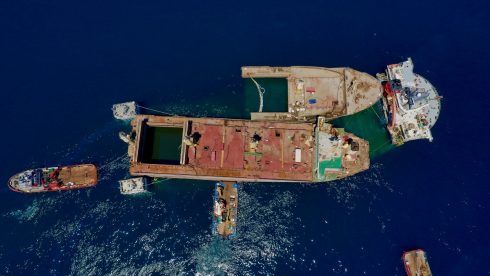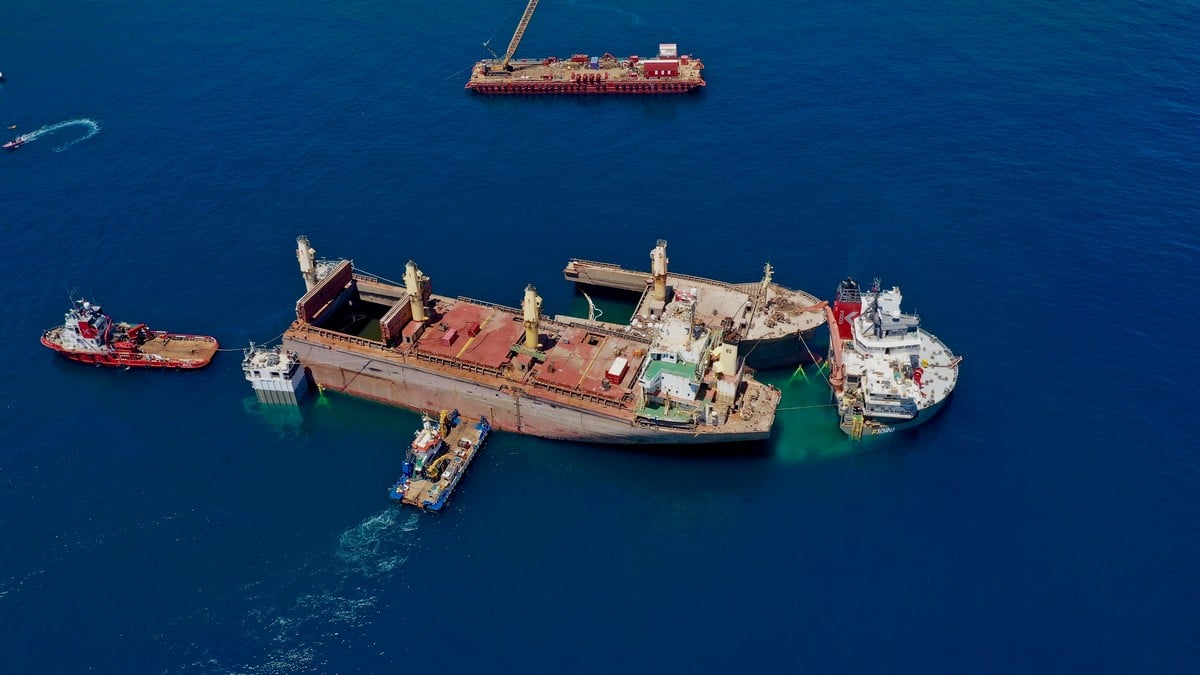OIL has spilled into the sea for the last time from the OS 35 as a semi-submersible barge finally hoisted the front and rear of the broken ship onto its platform.
Captain of the Port John Ghio remarked on the ‘success of this complex operation’ especially as booms caught most of the heavy oil.
But a government statement reported that ‘sheening is coming off the boomed section’ and cleaning is already underway to mop up the patches of oil.
It marks the end of the OS 35 accident that has been a constant threat to the Rock’s environment.
Cranes and tugs pulled the two broken sections of the OS 35 hull out of the water and onto the submerged Fjord ship on Monday afternoon.
The complex operation had required months of planning and careful preparation.
First, the wreck removers Koole Ltd refloated both the front and rear sections of the ship, stabilising them properly through high winds.
Relatively calm seas over the last three weeks made the final scooping of the two broken parts of the ship much simpler.
It all worked out in the end, nearly three weeks after the second port authority deadline of June 16.
The mammoth Fjord semi-submersible ship lowered its platform into the sea to its maximum of 19m to scoop up both sections of the shipwreck.
“As was anticipated, the raising of the two sections completely out of the water has released residues, including heavy oil residues into the protective boom that was deployed around the vessel,” the government said in a statement.
“Work is ongoing to clear these residues within the boomed area and to tackle the consequent sheening which is coming off the boomed section.
“This is expected to continue throughout the day, and possibly into tomorrow,” it added.

Tidying up
Authorities warned the public to keep away from the area while the cleanup continues.
As a precaution, workers had placed oil barriers at Catalan Bay and Eastern Beach.
But winds would be blowing westerly until early on Thursday, pushing it away from the Gibraltar and Spanish coastline.
Next, government agencies will survey the seabed around the site of the wreck to make sure they have removed all the wreckage.
The nearly 160-metre long Fjord will stay in Gibraltar for a couple more weeks to fasten the two hull sections before sailing to the Netherlands.
This will occur at a mooring in the port once the contractors finish preliminary works and remove oil residues from the boom around it.
“The success of this complex operation is a testament to the hard work and detailed planning that has been integral to the wreck removal operation throughout,” Ghio said.
“I’d like to thank the public for their understanding and ask once again for their cooperation as we work to protect Gibraltar’s coastline for the continued enjoyment of the bathing season.”
There is no more danger of any further oil spills, the government confirmed.
Minister for the Port Vijay Daryanani said he was ‘delighted’ to reach this milestone and thanked everyone who had helped remove the wreck.
He added that contractors had ‘safety and environmental protection as the top priority’ during the final removal of the wreck.
READ MORE:
- Gibraltar Government warns beach users to respect booms after paddlers break Sandy Bay oil guard
- Contractors lift bow of broken OS 35 to the surface allowing them to begin removing shipwreck
- Contractors delay ‘safe but steady’ removal of OS 35 shipwreck after refloating stern section
Click here to read more Gibraltar News from The Olive Press.








